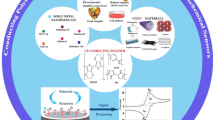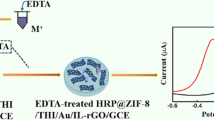Abstract
A glassy carbon electrode (GCE) was consecutively modified with amino groups and phosphate groups, and then loaded with Zr(IV) ions. Fourier transform infrared spectrophotometry, field-emission scanning electron microscopy, energy dispersive X-ray spectroscopy and cyclic voltammetry were used to characterize the morphologies and electrochemical properties. The sensor was used to detect p-nitrophenyl-substituted organophosphorus pesticides, with methyl-parathion (MP) as the model analyte. Under optimized conditions, the oxidation current of square wave voltammetry (typically measured at around −0.28 V vs. saturated calomel electrode) increases linearly in the 1.0 to 100 ng mL−1 MP concentration range, and the detection limit is 0.25 ng mL−1 (at a signal to noise ratio of 3). Average recoveries from (spiked) real water samples are 99.9–102.2%, with relative standard deviations of 0.3–2.6% (n = 3) at three levels. The reliability and accuracy of the method was validated by HPLC.

Zr(IV) modified GCE is prepared via three steps. The electrode shows high specificity and selectivity towards methyl‐parathion. And the linear range is 1.0 ‐ 100.0 ng mL‐1 with the detection limit as low as 0.25 ng mL‐1 with SWV.







Similar content being viewed by others
References
Jiang B, Dong P, Zheng J (2018) A novel amperometric biosensor based on covalently attached multilayer assemblies of gold nanoparticles, diazo-resins and acetylcholinesterase for the detection of organophosphorus pesticides. Talanta 183:114–121
WHO (2003) WHO recommended classification of pesticides by hazard and guidelines to classification 2000-01. Angel Losada Vázquez 32(2):99–115
Zhao E, Han L, Jiang S, Wang Q, Zhou ZH (2006) Application of a single-drop microextraction for the analysis of organophosphorus pesticides in juice. J Chromatogr A 1114(2):269–273
Manuela S, Barbara H, Peter P (2004) Determination of organophosphorus pesticides using membrane-assisted solvent extraction combined with large volume injection-gas chromatography-mass spectrometric detection. J Chromatogr A 1040(2):251–258
Sharma D, Nagpal A, Pakade YB, Katnoria JK (2010) Analytical methods for estimation of organophosphorus pesticide residues in fruits and vegens: a review. Talanta 82(4):1077–1089
Lacorte S, Barceló D (1996) Determination of parts per trillion levels of organophosphorus pesticides in groundwater by automated on-line liquid-solid extraction followed by liquid chromatography/atmospheric pressure chemical ionization mass spectrometry using positive and negative i. Anal Chem 68(15):2464–2470
Min W, Feng S (2017) Amperometric determination of organophosphate pesticides using a acetylcholinesterase based biosensor made from nitrogen-doped porous carbon deposited on a boron-doped diamond electrode. Microchim Acta 184(9):3461–3468
Zhao H, Ji X, Wang B, Wang N, Li X, Ni R, Ren J (2015) An ultra-sensitive acetylcholinesterase biosensor based on reduced graphene oxide-au nanoparticles-β-cyclodextrin/Prussian blue-chitosan nanocomposites for organophosphorus pesticides detection. Biosens Bioelectron 65:23–30
Zhai C, Sun X, Zhao W, Gong Z, Wang X (2013) Acetylcholinesterase biosensor based on chitosan/prussian blue/multiwall carbon nanotubes/hollow gold nanospheres nanocomposite film by one-step electrodeposition. Biosens Bioelectron 42:124–130
Zeng Y, Yu D, Yu Y, Zhou T, Shi G (2012) Differential pulse voltammetric determination of methyl parathion based on multiwalled carbon nanotubes-poly(acrylamide) nanocomposite film modified electrode. J Hazard Mater 217-218:315–322
Liu G, Lin Y (2005) Electrochemical stripping analysis of organophosphate pesticides and nerve agents. Electrochem Commun 7(4):339–343
Pan D, Ma S, Bo X, Guo L (2011) Electrochemical behavior of methyl parathion and its sensitive determination at a glassy carbon electrode modified with ordered mesoporous carbon. Microchim Acta 173(1–2):215–221
Ma JC, Zhang WD (2011) Gold nanoparticle-coated multiwall carbon nanotube-modified electrode for electrochemical determination of methyl parathion. Microchim Acta 175(3–4):309–314
Huang B, Zhang WD, Chen CH, Yu YX (2010) Electrochemical determination of methyl parathion at a Pd/MWCNTs-modified electrode. Microchim Acta 171(1–2):57–62
Wang M, Li Z (2008) Nano-composite ZrO2 /au film electrode for voltammetric detection of parathion. Sensors Actuators B Chem 133(2):607–612
Jiang L, Huang T, Feng S, Wang J (2016) Zirconium(IV) functionalized magnetic nanocomposites for extraction of organophosphorus pesticides from environmental water samples. J Chromatogr A 1456:49–57
Kohli P, Blanchard GJ (2006) Probing interfaces and surface reactions of zirconium phosphate/phosphonate multilayers using 31P NMR spectrometry. Langmuir 16(2):695–701
Takahiro T, Yoji K, Hideo H, Yoshinori Y, Nobuhiro K, Nobukazu KA, Mallouk TE (2006) Anodic electrodeposition of highly oriented zirconium phosphate and polyaniline-intercalated zirconium phosphate films. J Am Chem Soc 128(51):16634–16640
Wang L, Dong J, Wang Y, Cheng Q, Yang M, Cai J, Liu F (2016) Novel signal-amplified Fenitrothion electrochemical assay, based on glassy carbon electrode modified with dispersed graphene oxide. Sci Report 6:23409
Zhu D, Li Q, Pang X, Liu Y, Wang X, Chen G (2016) A sensitive electrochemical impedance immunosensor for determination of malachite green and leucomalachite green in the aqueous environment. Anal Bioanal Chem 408(20):5593–5600
Feng S, Ye M, Zhou H, Jiang X, Jiang X, Zou H, Gong B (2007) Immobilized zirconium ion affinity chromatography for specific enrichment of phosphopeptides in phosphoproteome analysis. Mol Cell Proteomics 6(9):1656–1665
Ou J, Li X, Feng S, Dong J, Dong X, Kong L, Ye M, Zou H (2007) Preparation and evaluation of a molecularly imprinted polymer derivatized silica monolithic column for capillary electrochromatography and capillary liquid chromatography. Anal Chem 79(2):639–646
Forato F, Liu H, Benoit R, Fayon F, Charlier C, Fateh A, Defontaine A, Tellier C, Talham DR, Queffã©Lec C (2016) Comparison of zirconium phosphonate-modified surfaces for immobilizing Phosphopeptides and phosphate-tagged proteins. Langmuir 32 (22):5480–5490
Hosseini H, Ahmar H, Dehghani A, Bagheri A, Fakhari AR, Amini MM (2013) Au-SH-SiO2 nanoparticles supported on metal-organic framework (au-SH-SiO2@cu-MOF) as a sensor for electrocatalytic oxidation and determination of hydrazine. Electrochim Acta 88:301–309
Devadas B, Rajkumar M, Chen SM, Yeh PC (2014) A novel voltammetric p-nitrophenol sensor based on ZrO2 nanoparticles incorporated into a multiwalled carbon nanotube modified glassy carbon electrode. Anal Methods 6(13):4686–4691
Ding SJ, Chang BW, Wu CC, Lai MF, Chang HC (2005) Impedance spectral studies of self-assembly of alkanethiols with different chain lengths using different immobilization strategies on au electrodes. Anal Chim Acta 554(1–2):43–51
Li Z, Yue Y, Hao Y, Feng S, Zhou X (2018) A glassy carbon electrode modified with cerium phosphate nanotubes for the simultaneous determination of hydroquinone, catechol and resorcinol. Microchim Acta 185(4):215
Narang J, Chauhan N, Pundir CS (2011) A non-enzymatic sensor for hydrogen peroxide based on polyaniline, multiwalled carbon nanotubes and gold nanoparticles modified au electrode. Analyst 136(21):4460–4466
Du D, Liu J, Zhang XY, Cui XL, Lin Y (2011) One-step electrochemical deposition of a graphene-ZrO2 nanocomposite: preparation, characterization and application for detection of organophosphorus agents. J Mater Chem 21(22):8032–8037
Chen S, Huang J, Du D, Li J, Tu H, Liu D, Zhang A (2011) Methyl parathion hydrolase based nanocomposite biosensors for highly sensitive and selective determination of methyl parathion. Biosens Bioelectron 26(11):4320–4325
Govindasamy M, Chen SM, Mani V, Akilarasan M, Kogularasu S, Subramani B (2017) Nanocomposites composed of layered molybdenum disulfide and graphene for highly sensitive amperometric determination of methyl parathion. Microchim Acta:1–9
Zhang T, Zeng L, Han L, Li T, Zheng C, Wei M, Liu A (2014) Ultrasensitive electrochemical sensor for p-nitrophenyl organophosphates based on ordered mesoporous carbons at low potential without deoxygenization. Anal Chim Acta 822:23–29
Tang X, Zhang T, Liang B, Han D, Zeng L, Zheng C, Li T, Wei M, Liu A (2014) Sensitive electrochemical microbial biosensor for p-nitrophenylorganophosphates based on electrode modified with cell surface-displayed organophosphorus hydrolase and ordered mesopore carbons. Biosens Bioelectron 60:137–142
Shaoqin L, Bjoern Bredenkötter A, Volkmer D (2002) The structure of self-assembled multilayers with Polyoxometalate nanoclusters. J Am Chem Soc 124(41):12279–12287
Dhull V (2018) Fabrication of AChE/SnO2-cMWCNTs/cu nanocomposite-based sensor electrode for detection of methyl parathion in water. Int J Anal Chem 2018:2874059
Acknowledgements
This work was supported by the National Natural Science Foundation of China [NSFC, Grant Nos. 21775126 and 21565023].
Author information
Authors and Affiliations
Corresponding author
Ethics declarations
The author(s) declare that they have no competing interests.
Additional information
Publisher’s note
Springer Nature remains neutral with regard to jurisdictional claims in published maps and institutional affiliations.
Y. Yue and L. Jiang was considered as co-first authors
Electronic supplementary material
ESM 1
(DOCX 245 kb)
Rights and permissions
About this article
Cite this article
Yue, Y., Jiang, L., Li, Z. et al. A glassy carbon electrode modified with a monolayer of zirconium(IV) phosphonate for sensing of methyl-parathion by square wave voltammetry. Microchim Acta 186, 433 (2019). https://doi.org/10.1007/s00604-019-3493-7
Received:
Accepted:
Published:
DOI: https://doi.org/10.1007/s00604-019-3493-7




